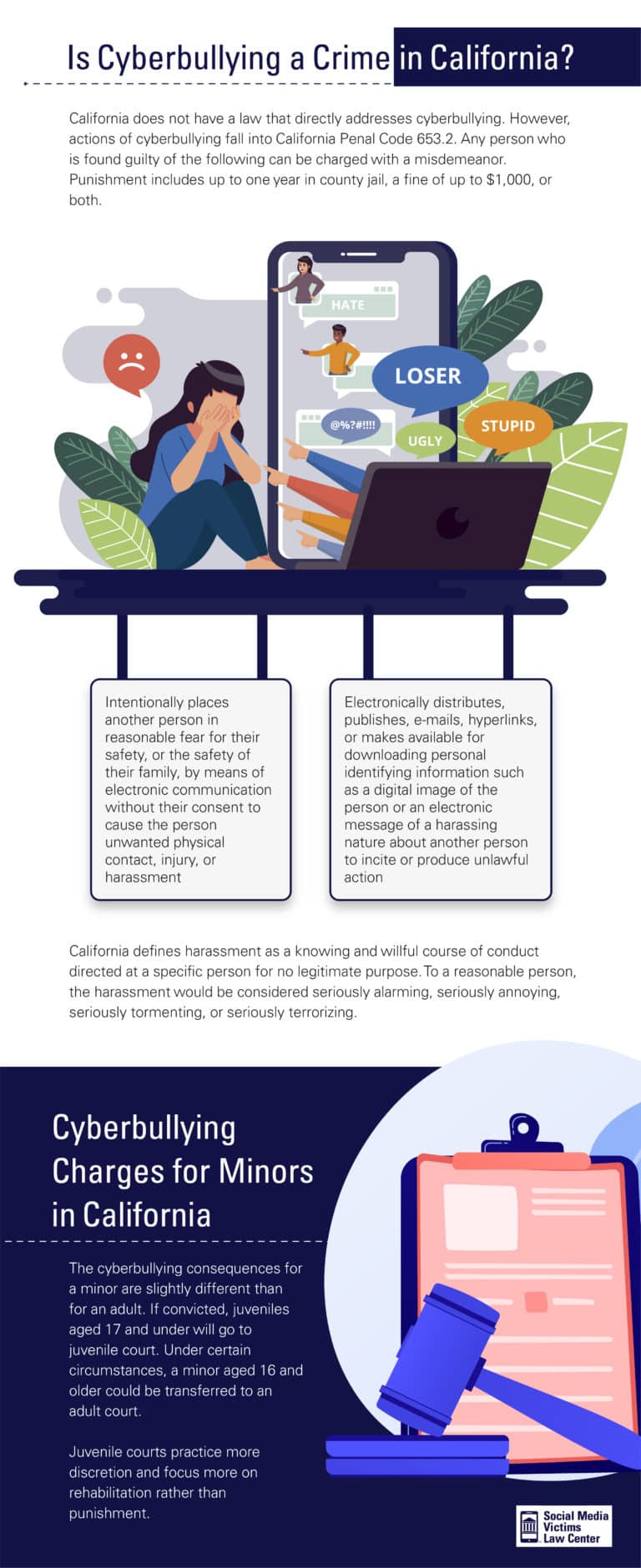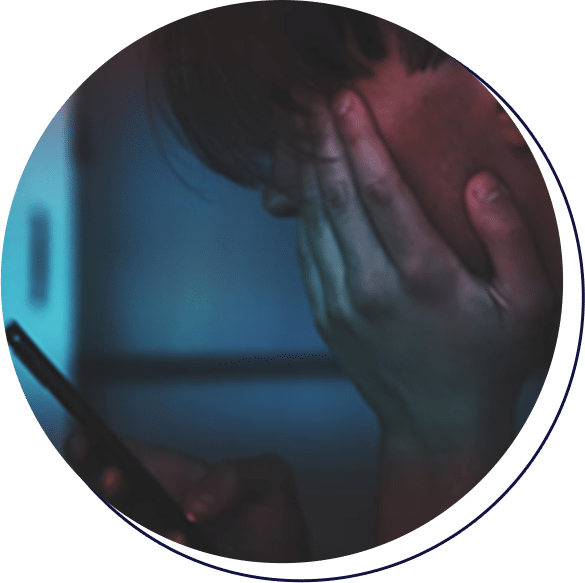Cyberbullying Laws in California
California’s legislature has passed multiple laws to address the widespread issues of cyberbullying and cyberstalking in the state. These laws help protect kids and teens who fall victim to online bullying and hold cyberbullies accountable for their actions.
 Written and edited by our team of expert legal content writers and reviewed and approved by Attorney Matthew Bergman
Written and edited by our team of expert legal content writers and reviewed and approved by Attorney Matthew Bergman
- Content last updated on:
- August 14, 2025
Written and edited by our team of expert legal content writers and reviewed and approved by

- Content last updated on:
- August 14, 2025
Cyberbullying is a relatively recent type of bullying that occurs through an electronic device. Unlike traditional bullying, the nature of cyberbullying allows perpetrators to be anonymous, hide behind screens, and engage in the conduct at any time, day or night.
According to a study by the Cyberbullying Research Center, nearly 46 percent of kids aged 13 to 17 have experienced cyberbullying. The top two forms of cyberbullying reported were rumors and mean or hateful comments.
Cyberbullying is often associated with school-aged children and teens, but anyone can experience it. In 2021, a Pew Research Center survey found that 41 percent of American adults have been victims of online harassment.
What is cyberbullying?
According to the American Psychological Association, cyberbullying occurs when a person uses technology to demean, inflict harm, or cause pain to another person through computers, cell phones, and other electronic devices.
Is cyberbullying a crime in California?

California does not have a law that directly addresses cyberbullying. However, actions of cyberbullying fall into California Penal Code 653.2. Any person who is found guilty of the following can be charged with a misdemeanor. Punishment includes up to one year in county jail, a fine of up to $1,000, or both.
- Intentionally places another person in reasonable fear for their safety, or the safety of their family, by means of electronic communication without their consent to cause the person unwanted physical contact, injury, or harassment
- Electronically distributes, publishes, e-mails, hyperlinks, or makes available for downloading personal identifying information such as a digital image of the person or an electronic message of a harassing nature about another person to incite or produce unlawful action
California defines harassment as a knowing and willful course of conduct directed at a specific person for no legitimate purpose. To a reasonable person, the harassment would be considered seriously alarming, seriously annoying, seriously tormenting, or seriously terrorizing.
Cyberbullying Charges for Minors in California
The cyberbullying consequences for a minor are slightly different than for an adult. If convicted, juveniles aged 17 and under will go to juvenile court. Under certain circumstances, a minor aged 16 and older could be transferred to an adult court.
Juvenile courts practice more discretion and focus more on rehabilitation rather than punishment.
Where does cyberbullying happen?
According to the U.S. Department of Health and Human Services’ stopbullying.gov, the following are places where cyberbullying occurs most often:
Signs of Cyberbullying
Signs of cyberbullying can manifest in the perpetrator and victim in various ways. The Cyberbullying Research Center provides the following warning signs that your child could be the victim of cyberbullying:
- Unexpectedly stops using their devices
- Appears uneasy about going to school or outside
- Appears angry or depressed after using their devices
- Avoids discussions about what they’re doing online
- Shows an increase or decrease in eating
- Seems regularly depressed
Alternatively, your child may exhibit the following warning signs if they are cyberbullying another person:
- Uses their devices at all hours of the night
- Switches screens or hides their devices when you approach
- Seems withdrawn or isolated from their family
- Laughs excessively when using their device and won’t share what is funny
- Demonstrates insensitivity and callousness toward others
- Appears conceited about their technological abilities and skills
What is Cyberstalking?
Cyberstalking is a form of cyberbullying. It falls under stalking in California Penal Code 646.9. Stalking is described as someone who willfully, maliciously, and repeatedly follows or harasses another person and makes a credible threat with the intent to instill reasonable fear for the person’s safety or the safety of their family.
Penalties for Cyberstalking
Cyberstalking is a crime in California and can be charged as a misdemeanor or felony. The penalties include up to one year in jail and a $1,000 fine if a misdemeanor. If a felony, the defendant can face up to two, three, or five years in prison and a $1,000 fine.
In some instances, the victim can place a restraining order on the defendant for up to 10 years.
Defendants can face further charges for violation. Additionally, they may be forced to register as a sex offender under California Penal Code 290 or face domestic violence charges under California Penal Code 273.5.

How California Schools Address Cyberbullying
Education Code Section 234-234.5, also known as the Safe Place to Learn Act, allows the state of California to ensure local educational agencies provide sufficient actions to reduce discrimination, harassment, violence, intimidation, and bullying.
California law requires school districts to:
- Adopt a policy that prohibits discrimination, harassment, intimidation, and bullying
- Adopt a process for receiving and investigating allegations of discrimination, harassment, intimidation, and bullying
- The process must include a requirement for school personnel to intervene, a timeline to investigate and resolve claims, and an appeal process.
- Publicize the policies and the complaint process and post them in all schools and offices
- Maintain documentation of all complaints and resolutions for at least one review cycle
- Protect complainants from retaliation and keep their identity confidential, if appropriate
The policy should include follow-up actions if bullying occurs. For example, a student involved in bullying as the perpetrator or victim may benefit from referral to a school counselor, school psychologist, social worker, or other school support personnel, as cyberbullying can negatively affect the child’s physical and mental health.
Additionally, the school district must inform the parent or legal guardian when their child is involved in bullying, harassment, or intimidation.
The California Department of Education must develop and post a training module on its website on bullying and cyberbullying for school staff, parents, students, and community members. The training material must contain information on identifying bullying and cyberbullying and procedures for addressing bullying and cyberbullying.
The department is required to update the training module every year.
Seth’s Law in California
Seth’s Law reinforces anti-bullying laws. It prohibits discrimination, harassment, intimidation, and bullying based on the following:
- Disability
- Gender
- Gender identity
- Gender expression
- Nationality
- Race or ethnicity
- Religion
- Sexual orientation
In accordance with Seth’s Law, school personnel who witness one of these acts must intervene.
Disciplinary Action for Students Who Cyberbully
Under Education Code 48900, if a student is found guilty of bullying using an electronic device, they are subject to suspension or expulsion.
The student must have committed the act:
- On school grounds
- Going to or coming from school
- During the lunch period on or off campus
- Going to, during, or coming from a school-sponsored activity
The following is considered bullying by an electronic act:
- Placing a pupil in fear of harm to the pupil’s person or property
- Causing the pupil to experience substantially detrimental effects on their physical or mental health
- Causing the pupil to experience substantial interference with their academic performance
- Causing the pupil to experience substantial interference with their participation in school activities, services, or privileges
An electronic act is the transmission of communication via an electronic device. This includes texts, messages, audio, video, images, and social media posts.
Posts on a social network website that fit the definition of bullying by an electronic act include:
- Posting to or creating a burn page with ill intent
- Impersonating another pupil with ill intent and without consent; this is a violation of California Penal Code 529
- Making a false profile of a fictitious pupil or profile using the attributes and likeness of an actual pupil with ill intent
Contact a Cyberbullying Lawyer in California Today
At the Social Media Victims Law Center, we have extensive experience dealing with cyberbullying. If you or a loved one is being cyberbullied, it is crucial that you report the cyberbullying, document the experience, and reach out to our team to schedule a free evaluation of your case.
Frequently Asked Questions
For individuals and children who have been
We only handle cases on a contingent fee basis. This means that we are paid a portion of any recovery obtained in the case and you do not owe us any attorneys’ fees if the lawsuit does not result in a recovery.
Every case is unique. Our attorneys will work with your family to evaluate your potential case and help you evaluate whether filing a lawsuit or other legal proceeding is in your family’s best interest. Generally speaking, the types of cases we handle involve serious mental health effects, including attempted or completed suicide, eating disorders, inpatient mental health treatment, or sexual trafficking/exploitation that was caused by or contributed to through addictive or problematic social media use by teens and young adults.
We are a law firm based near Seattle, WA comprised of lawyers who have spent their entire careers representing victims who have been harmed by dangerous products. We are also parents. Shocked and troubled by the recent revelations about the harm caused to teens and young adults by social media platforms, which powerful technology companies have designed to be highly addictive, Social Media Victims Law Center was launched specifically to help families and children who have suffered serious mental harm or exploitation through social media use to obtain justice.
Contact Us Today
Related Pages
Client Testimonials
Explore Popular Topics

Addiction

Suicide

Eating Disorders

Anxiety

Bullying

Sexual Abuse

Body Image

